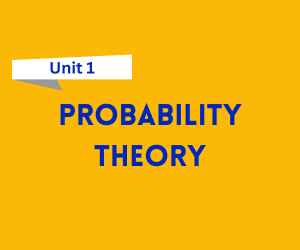Probability is the branch of mathematics that deals with measuring the likelihood of an event occurring. In business and decision-making, understanding probability helps organizations predict risks, forecast outcomes, and make informed choices. Whether it’s estimating the chances of sales growth or assessing market risks, probability provides the foundation for reliable predictions.

Download UNIT 1 – Probability and Probability Distributions Notes
Get simplified revision notes for this unit:
Download Unit 1 Notes PDF
Fundamentals of Probability
The probability of an event is a number between 0 and 1, where 0 means the event is impossible and 1 means it is certain to happen. For example, when tossing a fair coin, the probability of getting heads is 0.5.
There are two major approaches to understanding probability:
Classical Approach – Used when all outcomes are equally likely. Example: The probability of rolling a “4” on a fair six-sided die is 16\frac{1}{6}.
Empirical Approach – Based on actual observations or experiments. Example: If a company observes that 60 out of 100 deliveries are made on time, the probability of timely delivery is 0.6.
Laws of Probability
Two important laws form the backbone of probability theory:
Law of Addition – Used to find the probability of either of two events happening.
Example: The probability of selecting a red ball or a blue ball from a bag.
Law of Multiplication – Used to find the probability of two events happening together.
Example: The probability of selecting a red ball and a blue ball from two different bags.
Conditional Probability
Conditional probability is the probability of an event occurring given that another event has already happened.
Example: The probability that a customer will buy an accessory given that they have purchased a smartphone.
This concept is crucial in business analytics, especially in customer segmentation and targeted marketing.
Bayes’ Theorem
Bayes’ theorem is a method to update the probability of an event based on new information.
Example: A company estimates that 30% of customers prefer online shopping. If new survey data is available, Bayes’ theorem helps adjust this probability.
This is widely used in forecasting, spam filtering, and risk assessment.
Probability Distributions in Business
A probability distribution shows all possible outcomes of a random variable and their probabilities. Common types include:
Binomial Distribution – Used for situations with two outcomes (success or failure).
Example: The probability of getting exactly 3 defective items in a batch of 10.
Poisson Distribution – Models the number of events occurring in a fixed time or space.
Example: The number of customer complaints received in an hour.
Normal Distribution – A bell-shaped curve used in quality control and market research.
Example: Distribution of employee salaries or product lifespans.
Business Applications
Probability concepts help in:
Demand forecasting and inventory management.
Quality control and defect analysis.
Risk assessment in investments and insurance.
Customer behavior prediction in marketing.
